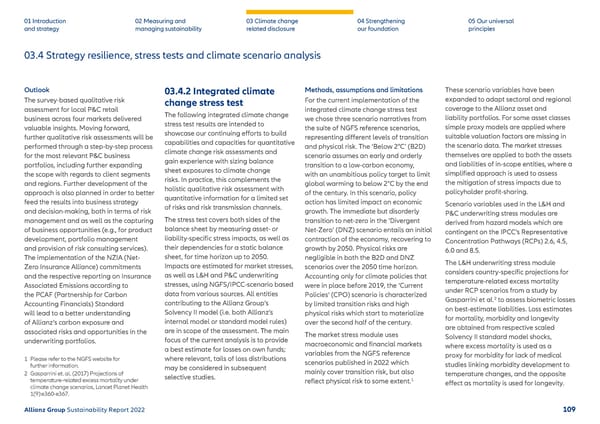03.4 Strategy resilience, stress tests and climate scenario analysis 01 Introduction and strategy 02 Measuring and managing sustainability 03 Climate change related disclosure 04 Strengthening our foundation 05 Our universal principles Outlook The survey-based qualitative risk assessment for local P&C retail business across four markets delivered valuable insights. Moving forward, further qualitative risk assessments will be performed through a step-by-step process for the most relevant P&C business portfolios, including further expanding the scope with regards to client segments and regions. Further development of the approach is also planned in order to better feed the results into business strategy and decision-making, both in terms of risk management and as well as the capturing of business opportunities (e.g., for product development, portfolio management and provision of risk consulting services). The implementation of the NZIA (Net- Zero Insurance Alliance) commitments and the respective reporting on Insurance Associated Emissions according to the PCAF (Partnership for Carbon Accounting Financials) Standard will lead to a better understanding of Allianz’s carbon exposure and associated risks and opportunities in the underwriting portfolios. 03.4.2 Integrated climate change stress test The following integrated climate change stress test results are intended to showcase our continuing efforts to build capabilities and capacities for quantitative climate change risk assessments and gain experience with sizing balance sheet exposures to climate change risks. In practice, this complements the holistic qualitative risk assessment with quantitative information for a limited set of risks and risk transmission channels. The stress test covers both sides of the balance sheet by measuring asset- or liability-specific stress impacts, as well as their dependencies for a static balance sheet, for time horizon up to 2050. Impacts are estimated for market stresses, as well as L&H and P&C underwriting stresses, using NGFS/IPCC-scenario based data from various sources. All entities contributing to the Allianz Group’s Solvency II model (i.e. both Allianz’s internal model or standard model rules) are in scope of the assessment. The main focus of the current analysis is to provide a best estimate for losses on own funds; where relevant, tails of loss distributions may be considered in subsequent selective studies. Methods, assumptions and limitations For the current implementation of the integrated climate change stress test we chose three scenario narratives from the suite of NGFS reference scenarios, representing different levels of transition and physical risk. The ‘Below 2°C’ (B2D) scenario assumes an early and orderly transition to a low-carbon economy, with an unambitious policy target to limit global warming to below 2°C by the end of the century. In this scenario, policy action has limited impact on economic growth. The immediate but disorderly transition to net-zero in the ‘Divergent Net-Zero’ (DNZ) scenario entails an initial contraction of the economy, recovering to growth by 2050. Physical risks are negligible in both the B2D and DNZ scenarios over the 2050 time horizon. Accounting only for climate policies that were in place before 2019, the ‘Current Policies’ (CPO) scenario is characterized by limited transition risks and high physical risks which start to materialize over the second half of the century. The market stress module uses macroeconomic and financial markets variables from the NGFS reference scenarios published in 2022 which mainly cover transition risk, but also reflect physical risk to some extent. 1 These scenario variables have been expanded to adapt sectoral and regional coverage to the Allianz asset and liability portfolios. For some asset classes simple proxy models are applied where suitable valuation factors are missing in the scenario data. The market stresses themselves are applied to both the assets and liabilities of in-scope entities, where a simplified approach is used to assess the mitigation of stress impacts due to policyholder profit-sharing. Scenario variables used in the L&H and P&C underwriting stress modules are derived from hazard models which are contingent on the IPCC’s Representative Concentration Pathways (RCPs) 2.6, 4.5, 6.0 and 8.5. The L&H underwriting stress module considers country-specific projections for temperature-related excess mortality under RCP scenarios from a study by Gasparrini et al. 2 to assess biometric losses on best-estimate liabilities. Loss estimates for mortality, morbidity and longevity are obtained from respective scaled Solvency II standard model shocks, where excess mortality is used as a proxy for morbidity for lack of medical studies linking morbidity development to temperature changes, and the opposite effect as mortality is used for longevity. 1 Please refer to the NGFS website for further information. 2 Gasparrini et. al. (2017) Projections of temperature-related excess mortality under climate change scenarios, Lancet Planet Health 1(9):e360-e367. Allianz Group Sustainability Report 2022 109
 Sustainability Report 2022 | Allianz Page 109 Page 111
Sustainability Report 2022 | Allianz Page 109 Page 111